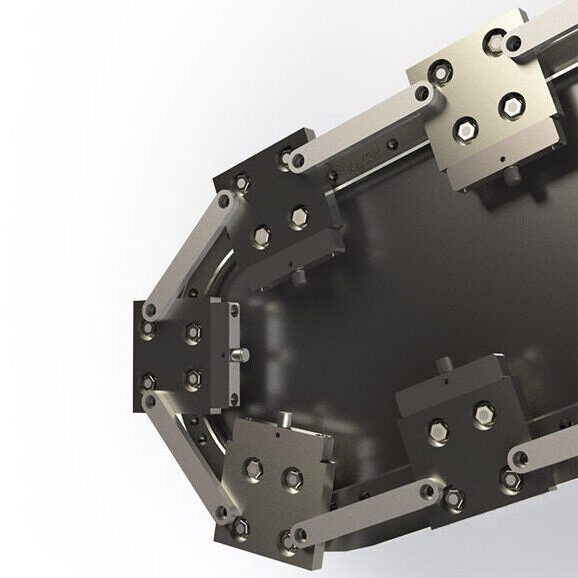Foundation dimensions: what and why
Core Question 1: Why does power warehousing need smart stacker cranes in concert with conveyor lines?
Power supplies cover insulators, cable trays and other heavy components and scattered small pieces, traditional warehousing faces three major pain points:
- Wide variation in specifications: Coexistence of heavy materials (over 1.5 tonnes) with light fittings, making manual handling inefficient and error-prone;
- High security risk: Insulators and other fragile products require millimetre-level positioning accuracy, and the breakage rate of manual operation exceeds 8%;
- Low space utilisation: The flat warehouse has a storage density of less than 40% and is expensive to expand.
synergistic valueThrough the linkage of stacker cranes (±2mm high-precision positioning) and conveyor lines (power roller/heavy-duty chain plate scenarios), "heavy-duty automatic access + light-duty goods-to-person picking" is realised, and the space utilisation rate is increased to 69%.
Core Question 2: How does an intelligent storage system for the power industry comprise?
Take the case of a provincial power company as an example:
- hardware layer::
- Heavy-duty area: intensive storage on 4-way shuttle + heavy-duty hoist (2 tonnes load);
- Light zone: miniload stacker + roller conveyor line (speed 1.5m/s);
- Manipulator: 3D vision camera + multi-fixture switching, solving the problem of depalletising bagged materials.
- software layer: WMS/WCS system integration with material coding (e.g. GS1 standard) and real-time scheduling of 200+ equipment nodes.
Scenario dimensions: how to do it vs. where to find it
Core issue 3: How to solve the problem of mixing heavy/light materials?
sub-scenario strategy::
- Heavy Duty Insulator Storage::
- The stacker cranes are equipped with double-deep forks, together with chain conveyor lines (carrying 1.5 tonnes/m2), with an inbound efficiency of 450 trays/hour;
- Conveyor lines are fitted with wear-resistant cladding to avoid metal scratches (surface hardness 85A).
- Parts picking::
- Lightweight roller line connecting the "goods-to-person" station, robots according to the order batch gripping (3D visual recognition error <0.5mm);
- Measured picking speed increased by 401 TP3T and manual intervention was reduced by 701 TP3T.
Core question 4: How can we ensure the safety of operations with high-risk materials?
Three-tier protection system::
- mechanical crashworthiness: Conveyor line set up mechanical block + laser distance measuring sensor (detection distance 8m), stacker emergency stop response ≤ 0.2 seconds;
- Dynamic collision avoidance: Electronic fence delineates a safe distance (automatic speed reduction within 1.5m horizontally), timestamp synchronisation error <0.5 sec;
- Emergency response mechanisms: Congestion over 85% triggers path reset, fault self-diagnosis accuracy 95%.
Solution Dimension: What if not/what happens
Core question 5: What happens if environmental adaptation is ignored?
Risk case: Storage of electrolyte in a substation warehouse without the use of corrosion-resistant conveyor lines:
- result: Ordinary carbon steel rollers rust in 3 months, downtime maintenance loss of 1.2 million / year;
- Optimisation programme::
- Conveyor line replacement with full stainless steel roller (SUS304) + PU rubber sleeve (acid and alkali resistant);
- Slope design ≥ 3° guides the liquid into the recycling tank and extends the life of the equipment to 8 years.
Core question 6: What happens if the system is not flexible enough?
lecture sb: A power warehouse's original system crashed due to fluctuating orders (a threefold surge in demand during the flood season):
- damages: Order fulfilment delayed by 22 hours, with fines exceeding $3 million;
- Upgrade programme::
- Conveyor lines with modular quick release couplings (line change ≤ 2 hours);
- The stacker task is enabled with the "lane balancing algorithm", which dynamically distributes the load and reduces the waiting time by 62%.
Comparison of the effectiveness of smart storage for electric power
| norm | pre-conversion | after conversion | Enhancement |
|---|---|---|---|
| Space utilisation | 38% | 69% | +82% |
| Inventory efficiency | 200 trays/hour | 680 torr/hour | +240% |
| Material breakage rate | 8% | 0.3% | -96% |
| human dependency | 100% | 30% | -70% |
Source: Yufeng Intelligent Power Project & FAW-Volkswagen Base Case Study
Future evolution: from automation to autonomous decision-making
- digital twin preview: Virtual mirroring to simulate scaling/failure scenarios and shorten the verification cycle by 70%;
- Carbon Footprint Optimisation: Load balancing algorithms to reduce the idle rate, unit order energy consumption down 18%;
- multi-network integration: Full coverage of 5G private network, solving the problem of network jitter in large-scale standing reservoirs, with command latency <20ms.
Intelligent warehousing in the power industry has shifted from "equipment replacing manual labour" to "data-driven decision-making", and the in-depth synergy between stacker cranes and conveyor lines is becoming the core technology base for ensuring the resilience of the energy supply chain.













